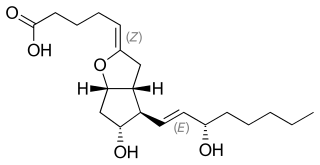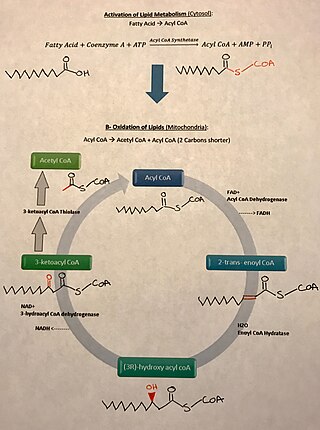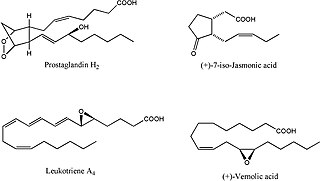Related Research Articles

Arachidonic acid is a polyunsaturated omega-6 fatty acid 20:4(ω-6), or 20:4(5,8,11,14). It is structurally related to the saturated arachidic acid found in cupuaçu butter. Its name derives from the New Latin word arachis (peanut), but peanut oil does not contain any arachidonic acid.

Eicosanoids are signaling molecules made by the enzymatic or non-enzymatic oxidation of arachidonic acid or other polyunsaturated fatty acids (PUFAs) that are, similar to arachidonic acid, around 20 carbon units in length. Eicosanoids are a sub-category of oxylipins, i.e. oxidized fatty acids of diverse carbon units in length, and are distinguished from other oxylipins by their overwhelming importance as cell signaling molecules. Eicosanoids function in diverse physiological systems and pathological processes such as: mounting or inhibiting inflammation, allergy, fever and other immune responses; regulating the abortion of pregnancy and normal childbirth; contributing to the perception of pain; regulating cell growth; controlling blood pressure; and modulating the regional flow of blood to tissues. In performing these roles, eicosanoids most often act as autocrine signaling agents to impact their cells of origin or as paracrine signaling agents to impact cells in the proximity of their cells of origin. Eicosanoids may also act as endocrine agents to control the function of distant cells.

Prostacyclin (also called prostaglandin I2 or PGI2) is a prostaglandin member of the eicosanoid family of lipid molecules. It inhibits platelet activation and is also an effective vasodilator.

Oxidative stress reflects an imbalance between the systemic manifestation of reactive oxygen species and a biological system's ability to readily detoxify the reactive intermediates or to repair the resulting damage. Disturbances in the normal redox state of cells can cause toxic effects through the production of peroxides and free radicals that damage all components of the cell, including proteins, lipids, and DNA. Oxidative stress from oxidative metabolism causes base damage, as well as strand breaks in DNA. Base damage is mostly indirect and caused by the reactive oxygen species generated, e.g., O2− (superoxide radical), OH (hydroxyl radical) and H2O2 (hydrogen peroxide). Further, some reactive oxidative species act as cellular messengers in redox signaling. Thus, oxidative stress can cause disruptions in normal mechanisms of cellular signaling.

Malondialdehyde (MDA) is the organic compound with the nominal formula CH2(CHO)2. A colorless liquid, malondialdehyde is a highly reactive compound that occurs as the enol. It occurs naturally and is a marker for oxidative stress.
Prostanoids are active lipid mediators that regulate inflammatory response. Prostanoids are a subclass of eicosanoids consisting of the prostaglandins, the thromboxanes, and the prostacyclins. Prostanoids are seen to target NSAIDS which allow for therapeutic potential. Prostanoids are present within areas of the body such as the gastrointestinal tract, urinary tract, respiratory and cardiology systems, reproductive tract and vascular system. Prostanoids can even be seen with aid to the water and ion transportation within cells. Prostanoids help release prostaglandins upon activation, receptors may open possibilities for treatments within different systems.

The two essential fatty acids are omega 3 and omega 6, which are required for a good human health. However, the effects of the ω-3 (omega-3) and ω-6 (omega-6) essential fatty acids (EFAs) are characterized by their interactions. The interactions between these two fatty acids has a direct effect on the signaling paths and biological functions like inflammation, protein synthesis, neurotransmitters in our brain and metabolic pathways in a human body.

The thromboxane receptor (TP) also known as the prostanoid TP receptor is a protein that in humans is encoded by the TBXA2R gene, The thromboxane receptor is one among the five classes of prostanoid receptors and was the first eicosanoid receptor cloned. The TP receptor derives its name from its preferred endogenous ligand thromboxane A2.
Isofurans are nonclassic eicosanoids formed nonenzymatically by free radical mediated peroxidation of arachidonic acid. The isofurans are similar to the isoprostanes and are formed under similar conditions, but contain a substituted tetrahydrofuran ring. The concentration of oxygen affects this process; at elevated oxygen concentrations, the formation of isofurans is favored whereas the formation of isoprostanes is disfavored.

Prostaglandin-endoperoxide synthase 2, also known as cyclooxygenase-2 or COX-2, is an enzyme that in humans is encoded by the PTGS2 gene. In humans it is one of two cyclooxygenases. It is involved in the conversion of arachidonic acid to prostaglandin H2, an important precursor of prostacyclin, which is expressed in inflammation.

Mead acid is an omega-9 fatty acid, first characterized by James F. Mead. As with some other omega-9 polyunsaturated fatty acids, animals can make Mead acid de novo. Its elevated presence in the blood is an indication of essential fatty acid deficiency. Mead acid is found in large quantities in cartilage.
Nonclassic eicosanoids are biologically active signaling molecules made by oxygenation of twenty-carbon fatty acids other than the classic eicosanoids.

Cyclooxygenase 1 (COX-1), also known as prostaglandin G/H synthase 1, prostaglandin-endoperoxide synthase 1 or prostaglandin H2 synthase 1, is an enzyme that in humans is encoded by the PTGS1 gene. In humans it is one of two cyclooxygenases.

Cytochrome P450 4F8 is a protein that in humans is encoded by the CYP4F8 gene.

Oxylipins constitute a family of oxygenated natural products which are formed from fatty acids by pathways involving at least one step of dioxygen-dependent oxidation. Oxylipins are derived from polyunsaturated fatty acids (PUFAs) by COX enzymes (cyclooxygenases), by LOX enzymes (lipoxygenases), or by cytochrome P450 epoxygenase.
Omega hydroxy acids are a class of naturally occurring straight-chain aliphatic organic acids n carbon atoms long with a carboxyl group at position 1, and a hydroxyl at terminal position n where n > 3. The C16 and C18 omega hydroxy acids 16-hydroxy palmitic acid and 18-hydroxy stearic acid are key monomers of cutin in the plant cuticle. The polymer cutin is formed by interesterification of omega hydroxy acids and derivatives of them that are substituted in mid-chain, such as 10,16-dihydroxy palmitic acid. Only the epidermal cells of plants synthesize cutin.

Prostaglandin G2 is an organic peroxide belonging to the family of prostaglandins. The compound has been isolated as a solid, although it is usually used in vivo. It quickly converts into prostaglandin H2, a process catalyzed by the enzyme COX.

13-Hydroxyoctadecadienoic acid (13-HODE) is the commonly used term for 13(S)-hydroxy-9Z,11E-octadecadienoic acid. The production of 13(S)-HODE is often accompanied by the production of its stereoisomer, 13(R)-hydroxy-9Z,11E-octadecadienoic acid. The adjacent figure gives the structure for the (S) stereoisomer of 13-HODE. Two other naturally occurring 13-HODEs that may accompany the production of 13(S)-HODE are its cis-trans isomers viz., 13(S)-hydroxy-9E,11E-octadecadienoic acid and 13(R)-hydroxy-9E,11E-octadecadienoic acid. Studies credit 13(S)-HODE with a range of clinically relevant bioactivities; recent studies have assigned activities to 13(R)-HODE that differ from those of 13(S)-HODE; and other studies have proposed that one or more of these HODEs mediate physiological and pathological responses, are markers of various human diseases, and/or contribute to the progression of certain diseases in humans. Since, however, many studies on the identification, quantification, and actions of 13(S)-HODE in cells and tissues have employed methods that did not distinguish between these isomers, 13-HODE is used here when the actual isomer studied is unclear.

9-Hydroxyoctadecadienoic acid has been used in the literature to designate either or both of two stereoisomer metabolites of the essential fatty acid, linoleic acid: 9(S)-hydroxy-10(E),12(Z)-octadecadienoic acid and 9(R)-hydroxy-10(E),12(Z)-octadecadienoic acid ; these two metabolites differ in having their hydroxy residues in the S or R configurations, respectively. The accompanying figure gives the structure for 9(S)-HETE. Two other 9-hydroxy linoleic acid derivatives occur in nature, the 10E,12E isomers of 9(S)-HODE and 9(R)-HODE viz., 9(S)-hydroxy-10E,12E-octadecadienoic acid and 9(R)-hydroxy-10E,12E-octadecadienoic acid ; these two derivatives have their double bond at carbon 12 in the E or trans configuration as opposed to the Z or cis configuration. The four 9-HODE isomers, particularly under conditions of oxidative stress, may form together in cells and tissues; they have overlapping but not identical biological activities and significances. Because many studies have not distinguished between the S and R stereoisomers and, particularly in identifying tissue levels, the two EE isomers, 9-HODE is used here when the isomer studied is unclear.
The neuroprostanes are prostaglandin-like compounds formed in vivo from the free radical-catalyzed peroxidation of essential fatty acids without the direct action of cyclooxygenase (COX) enzymes. The result is the formation of isoprostane-like compounds F4-, D4-, E4-, A4-, and J4-neuroprostanes which have been shown to be produced in vivo. These oxygenated essential fatty acids possess potent biological activity as anti-inflammatory mediators inhibiting the response of human macrophages that augment the perception of pain.
References
- ↑ Morrow, JD; Harris TM; Roberts LJ 2nd (1990). "Noncyclooxygenase oxidative formation of a series of novel prostaglandins: analytical ramifications for measurement of eicosanoids". Analytical Biochemistry. 184 (1): 1–10. doi:10.1016/0003-2697(90)90002-q. PMID 2321745.
- ↑ Morrow, JD; Hill KE; Burk RF; Nammour TM; Badr KF; Roberts LJ 2nd (1990). "A series of prostaglandin F2-like compounds are produced in vivo in humans by a non-cyclooxygenase, free radical-catalyzed mechanism". Proceedings of the National Academy of Sciences USA. 87 (23): 9383–9387. Bibcode:1990PNAS...87.9383M. doi: 10.1073/pnas.87.23.9383 . PMC 55169 . PMID 2123555.
- ↑ COX activity produces H2O2 which may non-enzymatically produce isoprostanes.
- ↑ Morrow JD, Roberts LJ (1996). "The isoprostanes. Current knowledge and directions for future research". Biochem. Pharmacol. 51 (1): 1–9. doi:10.1016/0006-2952(95)02072-1. PMID 8534261.
- ↑ Evans AR, Junger H, Southall MD, et al. (2000). "Isoprostanes, novel eicosanoids that produce nociception and sensitize rat sensory neurons". J. Pharmacol. Exp. Ther. 293 (3): 912–20. PMID 10869392.
- ↑ Seet, Raymond C.S.; Lee, Chung-Yung J.; Loke, Wai Mun; Huang, Shan Hong; Huang, Huiwen; Looi, Woan Foon; Chew, Eng Soh; Quek, Amy M.L.; et al. (2011). "Biomarkers of oxidative damage in cigarette smokers: Which biomarkers might reflect acute versus chronic oxidative stress?". Free Radical Biology and Medicine . 50 (12): 1787–1793. doi:10.1016/j.freeradbiomed.2011.03.019. PMID 21420490.
- ↑ Janssen LJ (2001). "Isoprostanes: an overview and putative roles in pulmonary pathophysiology". Am. J. Physiol. Lung Cell Mol. Physiol. 280 (6): L1067–82. doi: 10.1152/ajplung.2001.280.6.L1067 . PMID 11350785 . Retrieved 2007-11-02.